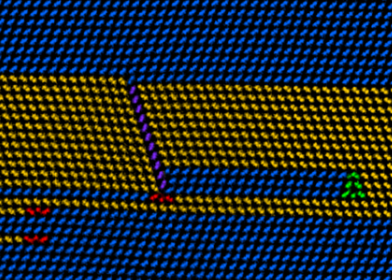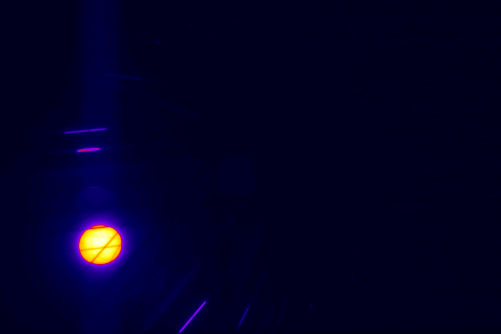Microscopy Group
Microscopy Group Research Nuggets
Electrostatic shielding for dendrite suppression in aqueous zinc batteries
Electrolyte engineering is one of the best ways to improve rechargeable battery performance. The aqueous zinc battery is a potentially safe and cheap battery technology for grid-scale storage, yet suffers from poor performance due to dendrite growth. We identify a mechanism for preventing dendrite growth by changing the electrolyte. Click the image to find out more.
Ferroelectric incommensurate spin crystals
Ferroics can form complex topological spin structures when subjected to particular physical boundaries. A domain structure in a PbTiO3 layer between SrRuO3 electrodes has been discovered with two orthogonal periodic modulations that form an incommensurate polar crystal, and provides a ferroelectric analogue to recently discovered incommensurate spin crystals in ferromagnetic materials. Click the image to find out more.
Interlayer Umklapp hybridisation of bands in 2D heterostructures
Interlayer effects within 2D heterostructures can be studied using spatially-resolved angle-resolved photoemission spectroscopy (microARPES). We show how twist-controlled Umklapp scattering of hybridised electronic states can be used to engineer discrete positions of strong coupling between two 2D materials. Click the image to find out more.
Current-Density-Dependent Electroplating in Ca Electrolytes
Calcium-ion rechargeable batteries are promising emerging candidates for beyond lithium-ion, in part due to the better stability of calcium metal. To exploit this advantage we need to better understand how new calcium electrolytes perform, and particularly the conditions under which dangerous metal dendrites may form. We use operando electrochemical TEM, effectively a micro-battery operated inside the microscope, to image dendrite formation in real-time. Click the video to find out more.
Direct observation and catalytic role of mediator atom in 2D materials
Atomic defects govern material behaviour, most clearly seen with the case of dislocation migration and plasticity. It is understood that defect changes occur via sequential atomic bond rotations; however, modelling tells us the energy barrier for these are high. By combining monochromated aberration corrected TEM imaging of graphene - resolving individual carbon atoms - with TBMD and DFT modelling, we reveal the role of surface adatoms in mediating lower energy defect migration mechanisms. Click the image to find out more.
AI-enabled Cryogenic Electron Ptychography For Bio-macromolecule Imaging
Nobel Prize winning technique, cryogenic electron microscopy (cryo-EM) is a powerful method for visualizing a wide range of biological macromolecules in three dimensions at near-atomic resolution, which can provide direct insights into function and mechanism. Here, we are developing a completely new computational microscopy so called cryogenic electron ptychography, further enhanced by artificial intelligence (AI) and machine learning techniques to recover high fidelity amplitude and phase contrast images of biological macromolecules with state-of-the-art ultrafast detectors at low dose. Click the image to find out more.
Development of in situ Multi-channel 5D STEM Imaging for Functional Materials
Unlike conventional imaging modes, we are developing novel computational diffractive imaging techniques (ptychography, 4D STEM) at a cryogenic temperature together with “big data” processing methods and exploiting opportunities by accelerating its application in functional materials ranging from battery to quantum materials. Furthermore, we are looking at dynamic behaviours of materials in situ and study how they respond to a changing external stimulus (such as electric, magnetic field, temperature and light) at timescales required. Click the image to find out more.
Visualizing electrostatic gating effects in 2D heterostructures
The ability to directly monitor the states of electrons in modern field-effect devices could transform our understanding of the physics and function of a device. We show that micrometre-scale, angle-resolved photoemission spectroscopy (microARPES) applied to two-dimensional van der Waals heterostructures affords this ability, visualizing field-dependent band structure with in-operando measurements. Both optical spectroscopy and microARPES can be carried out on a single device, allowing definitive studies of the relationship between gate-controlled electronic and optical properties. Click the image to find out more.
Revealing Defect Dynamics in III-V Nanowires
For functional applications in next generation technology, semiconductor nanowires should be free of defects that can be detrimental to device performance. Defects in self-catalysed nanowires, produced with sub-optimal growth conditions, have been analysed to identify defect types. In-situ microscopy has been utilised to probe defect dynamics and helps us to understand how to improve nanowire quality. Click the image to find out more.
D-LACBED: Digital Large Angle Convergent Beam Electron Diffraction
By combining lots of individual CBED patterns acquired using computer control of beam tilt, LACBED patterns can be reconstructed. The LACBED patterns provide a wealth of information about sample symmetry and can even be used to solve crystal structure. Click the image to find out more.
Inline electron holography of Graphene and fluorinated Graphene
One of the most desirable goals of graphene research is to produce ordered two-dimensional (2D) chemical derivatives of suitable quality for monolayer device fabrication. Here we reveal, by focal series exit wave reconstruction (EWR), that C2F chair is a stable graphene derivative and demonstrates pristine long-range order limited only by the size of a functionalized domain. Focal series of images of graphene and C2F chair were obtained in an aberration-corrected transmission electron microscope. Restored phase indicate that, within an ordered domain, functionalization occurs on one side only as theory predicts. In addition, we show that electron diffraction provides a quick and easy method for distinguishing between graphene, C2F chair and fully fluorinated stoichiometric CF 2D phases.
1D Radial van der Waals Heterostructures
Heterostructures built from 2D, atomically thin crystals are bound by the van der Waals force and exhibit unique optoelectronic properties. On the other hand, 1D van der Waals heterostructures comprise of encapsulated nanotubes of 2D atomically thin carystals. One of the important 1D van der Waals heterostructures made of carbon nanotubes wrapped by atomically thin nanotubes of boron nitride and molybdenum disulfide (MoS2). The high quality of the composite was directly made evident on the atomic scale by transmission electron microscopy, and on the macroscopic scale by a study of the heterostructure’s equilibrium and ultrafast optoelectronics. Ultrafast pump–probe spectroscopy across the visible and terahertz frequency ranges identified that, in the MoS2 nanotubes, excitons coexisted with a prominent population of free charges. The electron mobility was comparable to that found in high-quality atomically thin crystals. The high mobility of the MoS2 nanotubes highlights the potential of 1D van der Waals heterostructures for nanoscale optoelectronic devices.























